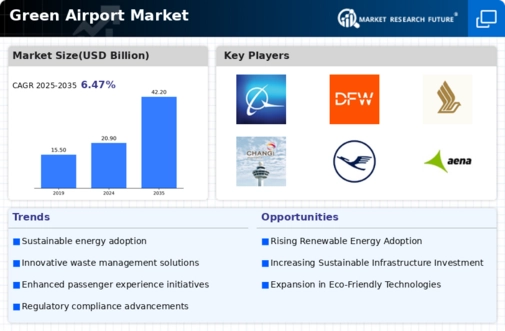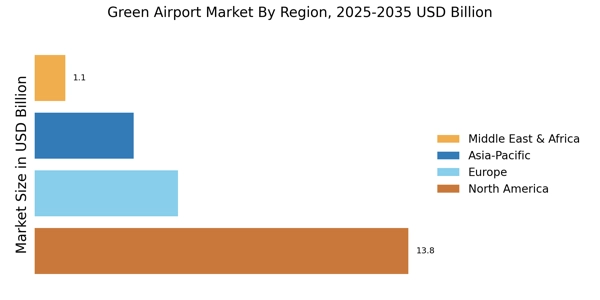Regulatory Support for Sustainability
The Green Airport Market is experiencing a surge in regulatory support aimed at promoting sustainability. Governments are increasingly implementing stringent environmental regulations that encourage airports to adopt eco-friendly practices. For instance, policies mandating reductions in carbon emissions and waste management are becoming commonplace. This regulatory framework not only compels airports to invest in green technologies but also provides financial incentives for compliance. As a result, airports are likely to allocate resources towards renewable energy sources and sustainable infrastructure. The International Civil Aviation Organization has set ambitious targets for carbon neutrality, which further propels the Green Airport Market forward. The alignment of regulatory measures with sustainability goals indicates a robust future for eco-conscious airport operations.
Investment in Sustainable Infrastructure
Investment in sustainable infrastructure is a key driver of the Green Airport Market. Airports are increasingly recognizing the long-term benefits of developing eco-friendly facilities. This includes the construction of energy-efficient terminals, the use of sustainable materials, and the implementation of rainwater harvesting systems. According to recent estimates, investments in green infrastructure can yield returns of up to 20% over time, making it an attractive option for airport authorities. Additionally, partnerships with private investors and green technology firms are becoming more common, facilitating the funding of innovative projects. As airports prioritize sustainability in their development plans, the Green Airport Market is poised for growth, reflecting a commitment to environmental stewardship and operational efficiency.
Technological Advancements in Airport Operations
Technological advancements are playing a pivotal role in shaping the Green Airport Market. Innovations such as automated systems, energy-efficient lighting, and advanced waste management solutions are being integrated into airport operations. These technologies not only enhance operational efficiency but also significantly reduce the environmental footprint of airports. For example, the implementation of smart grid technology allows airports to optimize energy consumption, leading to a potential reduction in energy costs by up to 30%. Furthermore, the rise of electric ground support equipment is transforming the way airports manage their fleets. As these technologies continue to evolve, they are likely to drive the Green Airport Market towards more sustainable practices, ultimately benefiting both the environment and airport stakeholders.
Growing Public Awareness and Demand for Sustainability
Public awareness regarding environmental issues is on the rise, influencing the Green Airport Market. Travelers are increasingly prioritizing sustainability when choosing airlines and airports, leading to a demand for greener operations. Surveys indicate that a significant percentage of passengers are willing to pay extra for eco-friendly services, which compels airports to adopt sustainable practices. This shift in consumer behavior is prompting airports to invest in green technologies and initiatives, such as carbon offset programs and sustainable building designs. The growing expectation for transparency in environmental practices further drives airports to showcase their sustainability efforts. As public demand for greener travel options continues to grow, the Green Airport Market is likely to expand, aligning with the values of environmentally conscious travelers.
Collaboration with Stakeholders for Sustainable Practices
Collaboration among various stakeholders is emerging as a crucial driver in the Green Airport Market. Airports are increasingly engaging with airlines, government agencies, and local communities to develop and implement sustainable practices. This collaborative approach fosters the sharing of best practices and resources, enhancing the overall effectiveness of sustainability initiatives. For instance, joint efforts in carbon reduction strategies and waste management programs can lead to more comprehensive solutions. Furthermore, stakeholder collaboration often results in innovative funding mechanisms, enabling airports to pursue ambitious green projects. As partnerships strengthen, the Green Airport Market is likely to benefit from a more unified approach to sustainability, ultimately leading to enhanced operational performance and reduced environmental impact.


















Leave a Comment